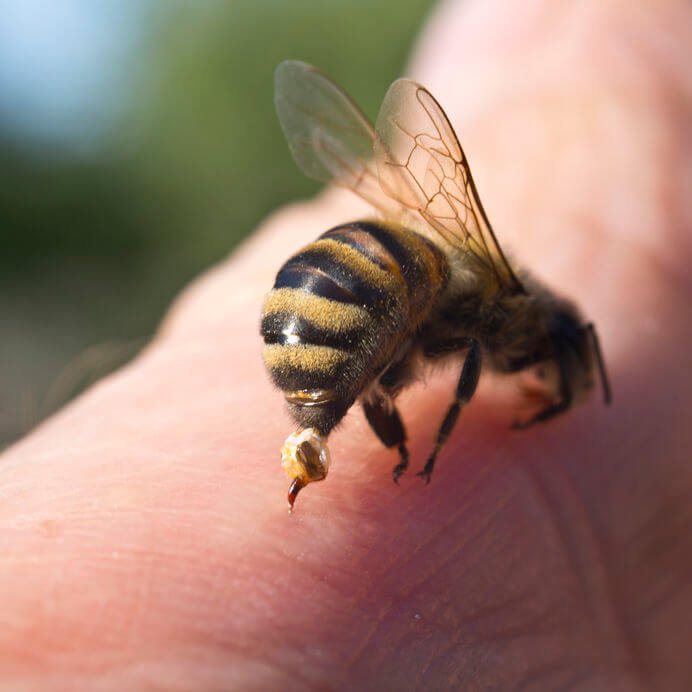2020-09-10
While many of us curse the painful sting of a bee, it is a boon for people affected by a deadly disease, cancer. In a study published on September 4th in the Nature Journal, Precision Oncology, a group of scientists revealed that a molecule found in the bee venom holds the potential to treat cancer.
By Ruchi Jhonsa, Ph.D.
Honeybee venom is a complex mixture of substances designed to protect bees against predators. It includes biologically active peptides like melittin, a major component of bee venom that gives the sensation of pain at the sting site. Melittin is a positively charged 26-amino acid peptide that causes cell death by forming pores in the cell membrane. Traditionally, bee venom is used as an anti-inflammatory agent for the treatment of rheumatoid arthritis and multiple sclerosis. But it is also shown to have anti-cancerous properties with demonstrated cytotoxic effects on various cancer lines, including melanoma, NSCLC, glioblastoma, leukemia, ovarian, cervical, and pancreatic cancers.
To date, however, studies have not thoroughly investigated the bee venom’s mechanism in the breast cancer arena. This report tries to unfurl the mechanism of action of bee venom on two contrasting types of breast cancer, which are extremely aggressive and associated with the poorest outcomes. Triple-negative breast cancer (TNBC) unlike other subtypes lacks expression of estrogen and progesterone receptors and human epidermal growth factor receptor 2 or HER2, whereas HER2-positive breast cancers have high expression of HER2. Currently available treatments either target EGFR, a receptor highly expressed in TNBC, or target HER2 in HER2-enriched tumors. While HER2 targeted therapies are effective to a certain extent, EGFR targeted treatments are seldom effective for this TNBC subtype of cancer.
Apitherapy Halts Breast Cancer Growth
Using the venom from over 300 honeybees and bumblebees in England, Ireland, Perth, Western Australia, the researchers showed that even the most aggressive forms of breast cancer are susceptible to venom and melittin in its pure form. The high anti-cancer activity was observed in TNBC and HER2-enriched breast cancer cell lines bathed in venom within 1 hour of exposure. But, most importantly, there was a minimal cytotoxic effect of venom on normal cells, a quality that is desirable of any cancer therapy. Besides killing the cells, Venom and Mellitin also suppressed the cells’ growth by suppressing phosphorylation of the growth factor receptors, EGFR, and HER2 within 20 minutes of exposure. Phosphorylation is required for the dimerization of the growth receptors essential for the relay of growth signals. This set of experiments demonstrated that, before killing the cells, melittin paralyzes the cell’s growth by affecting growth signaling.
Combination of Melittin With Chemotherapy is Effective
When combined with docetaxel, a chemotherapeutic agent, Melittin could further suppress the growth of breast cancer. In the in-vivo experiment, mice were administered breast cancer cells, giving rise to tumors in the body. Three days after the generation of tumors, mice were either treated with a combination of melittin and chemotherapy or melittin alone. The group found that “tumor control was superior compared to either treatment alone, particularly on days 7 and 9 post-inoculation of cancer cells.”
While melittin showed synergy with a chemotherapeutic agent, it simultaneously reduced the levels of checkpoint protein, PD-L1 in tumors. PD-L1 protein is well known for its pro-tumor effect in the tumor microenvironment. The negative impact of melittin on checkpoint protein is quite desirable and could improve anti-tumoral immune responses for several chemotherapeutic agents. This effect also resembles melittin’s response in the previous studies wherein the peptide was shown to reduce tumor-promoting macrophage population in the tumor microenvironment.
Melittin Augments Existing Breast Cancer Therapies
Melittin treatment in combination with chemotherapy, makes a better case as breast cancer therapy as this type of cancer has a high expression of HER2 and EGFR along with checkpoint protein, PD-L1. Melittin could also augment treatments with antibody-drug conjugates such as Trastuzumab where melittin’s membrane disrupting properties could enhance the cytotoxic payload’s internalization. Linking melittin with toxins or prodrugs is another approach that could be exploited in the future. While all looks good for bee venom, its toxicity and tolerance in the human body have not been determined. Therefore, future studies are warranted before melittin could be potentially used to treat cancer in humans.











